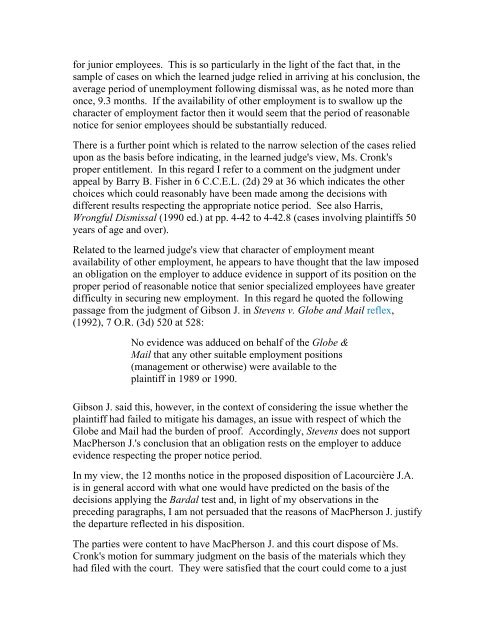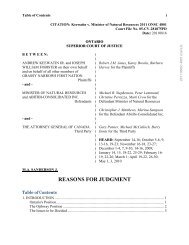Cronk v. Canadian General Insurance Co., 1995 CanLII 814 (ON CA)
Cronk v. Canadian General Insurance Co., 1995 CanLII 814 (ON CA)
Cronk v. Canadian General Insurance Co., 1995 CanLII 814 (ON CA)
You also want an ePaper? Increase the reach of your titles
YUMPU automatically turns print PDFs into web optimized ePapers that Google loves.
for junior employees. This is so particularly in the light of the fact that, in the<br />
sample of cases on which the learned judge relied in arriving at his conclusion, the<br />
average period of unemployment following dismissal was, as he noted more than<br />
once, 9.3 months. If the availability of other employment is to swallow up the<br />
character of employment factor then it would seem that the period of reasonable<br />
notice for senior employees should be substantially reduced.<br />
There is a further point which is related to the narrow selection of the cases relied<br />
upon as the basis before indicating, in the learned judge's view, Ms. <strong>Cronk</strong>'s<br />
proper entitlement. In this regard I refer to a comment on the judgment under<br />
appeal by Barry B. Fisher in 6 C.C.E.L. (2d) 29 at 36 which indicates the other<br />
choices which could reasonably have been made among the decisions with<br />
different results respecting the appropriate notice period. See also Harris,<br />
Wrongful Dismissal (1990 ed.) at pp. 4-42 to 4-42.8 (cases involving plaintiffs 50<br />
years of age and over).<br />
Related to the learned judge's view that character of employment meant<br />
availability of other employment, he appears to have thought that the law imposed<br />
an obligation on the employer to adduce evidence in support of its position on the<br />
proper period of reasonable notice that senior specialized employees have greater<br />
difficulty in securing new employment. In this regard he quoted the following<br />
passage from the judgment of Gibson J. in Stevens v. Globe and Mail reflex,<br />
(1992), 7 O.R. (3d) 520 at 528:<br />
No evidence was adduced on behalf of the Globe &<br />
Mail that any other suitable employment positions<br />
(management or otherwise) were available to the<br />
plaintiff in 1989 or 1990.<br />
Gibson J. said this, however, in the context of considering the issue whether the<br />
plaintiff had failed to mitigate his damages, an issue with respect of which the<br />
Globe and Mail had the burden of proof. Accordingly, Stevens does not support<br />
MacPherson J.'s conclusion that an obligation rests on the employer to adduce<br />
evidence respecting the proper notice period.<br />
In my view, the 12 months notice in the proposed disposition of Lacourcière J.A.<br />
is in general accord with what one would have predicted on the basis of the<br />
decisions applying the Bardal test and, in light of my observations in the<br />
preceding paragraphs, I am not persuaded that the reasons of MacPherson J. justify<br />
the departure reflected in his disposition.<br />
The parties were content to have MacPherson J. and this court dispose of Ms.<br />
<strong>Cronk</strong>'s motion for summary judgment on the basis of the materials which they<br />
had filed with the court. They were satisfied that the court could come to a just
















